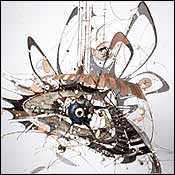
For certain gentle but clear-eyed children who love forests, animals, and all growing things, there comes a moment of intense shock—adult shock—when nature’s cruelty can no longer be ignored. The beauty of the world is not forgotten, but neither is Tennyson’s “Nature, red in tooth and claw.” The revelatory wound of recognition flares across the imagination, and never quite heals. I don’t know whether the sculptor Lee Bontecou was such a child, but her art has that character. She doesn’t attempt to resolve the troubling paradoxes of existence. She is at once lyrical and menacing, rational and mystical, dark and light-filled. Life and death, in her work, are inextricably intertwined.
Organized by the Museum of Contemporary Art in Chicago and the UCLA Hammer Museum in Los Angeles, Lee Bontecou: A Retrospective, which recently opened at MoMA QNS, includes roughly 100 works—about 50 sculptures and 50 drawings—that the artist made between the late fifties and 2000. The show is attracting particular interest because Bontecou, after some early success, withdrew from the art world; her last show in New York was in 1971. In the late fifties, she began making what came to be known as soot drawings, which convey with Zenlike simplicity the tension at the center of her art. The black in the drawings, made from soot, is not empty- or flat-looking. The soot is organic. It creates a rich darkness steeped in memory: If the drawings evoke the endlessness of space, the void also seems lustrous. Bontecou’s black captures, dead-on, the sort of excited despair typical of existential thinking in the late forties and fifties.
She is best known, however, for an extraordinary series of abstract sculptures created between 1959 and 1967. Most are three-dimensional pieces mounted on a wall. Constructed from canvas and other materials stretched onto welded steel armatures, the sculptures are bulbous and faceted, like an insect’s eye or a landscape seen from a plane. The stretched material, usually yellowish in tone, evokes human skin. The coloring and coarse textures also suggest army blankets, jackets, and helmets; the mud and horror of war seem to infuse the work. The defining element of these sculptures, however, is a yawning circular hole that could be the mouth of a cannon, a pit, an eye, a window, a tunnel. If Bontecou made a certain black her own, she did the same for the circle. This mysteriously black “Bontecou circle” is hypnotic. It reflects both inner and outer space. It has a peculiar weight, a black-hole gravity, that draws in the world.
“Bontecou’s circles have a peculiar weight, a black-hole gravity, that draws in the world.”
In the late sixties, Bontecou began to work more directly with nature. Her palette lightened. Her pieces lost weight and gained air, becoming less burly in appearance. She experimented with new materials, molding plastics into forms that evoked or described fish, animals, insects, and plants. Although in some ways more lyrical than her early sculpture, the new work displayed a similar commitment to paradox. Bontecou’s line was never just delicate; it had a dragonfly delicacy. One beautiful, light-filled fish has razorlike teeth. Another resembles those monstrous finned creatures that live at the bottom of the ocean and seem to come from the beginning of time. Or perhaps—in the sort of connection characteristic of her art—the ancient creatures are instead a nightmare of the future, a mutation brought about by the abuse of technology and science.
Bontecou, who is now 73 years old, began making porcelain-and-wire sculptures—several hang like mobiles—about two decades ago. Some have taken, in the end, twenty years to finish. They are remarkably elaborate and meticulously made, glittering with tiny wires and welded metals. They are often likened to planetary or astral forms, but also resemble the intimate universe spied through an electron microscope. Like all of Bontecou’s work, the recent sculptures appear uncannily alive, as skeletons sometimes do. They contain many little circles, like eyes, and are dense with swirling connection: The viewer’s own eye cannot fully take in the elaborate twists and turns of the linear forms. And yet there is never anything tangled, messy, or unstable about a Bontecou sculpture. It comes into balance, like so many angels on the head of a pin.